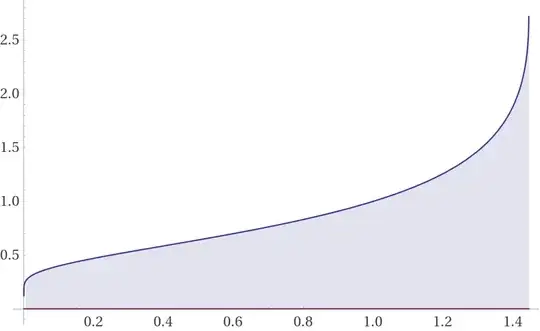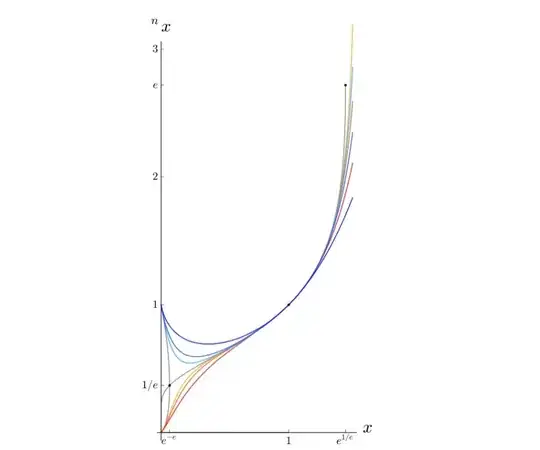I have been trying to find an interesting constant over the domain of the infinite tetration of x and have just almost figured out the area with a non integral infinite sum representation. Just one constant is in my way. D denotes the domain. This question is different from this one as it has the full domain such that the imaginary part is $0$ and not for a single point. Here is a demo of my expansion. Here is my source for the product logarithm/W-Lambert function series. My inspiration for the series is here.
Finally here is a graph of the constant. My work is as follows. I used a bit of software to help with the evaluation at the end. Here is data about the generalized incomplete gamma function used here.
$$ \mathrm{G=\int_D x^{x^{x^…}}dx=\int_D {^\infty x}\, dx=\int_D-\frac{W(-ln(x))}{ln(x)}dx= 1.265188689361227081430914184615901039501069191363542653701819999950085943915822836313002058708863484…\implies G+\int_0^{\sqrt[-e]e }\frac {W(-ln(x))}{ln(x)}dx= \int_{\sqrt[-e]e}^{\sqrt[e]e}\frac {W(-ln(x))}{ln(x)}dx= \sum_{n=1}^\infty\frac{n^{n-1}}{n!} \int_{\sqrt[-e]e}^{\sqrt[e]e} ln^{n-1}(x)dx= \sum_{n=1}^\infty\frac{(-n)^{n-1}}{n!}Γ\left(n,-\frac 1e,\frac 1e\right)=\sum_{n=1}^\infty\frac{(-n)^{n-1}}{n}Q\left(n,-\frac 1e, \frac 1e\right)= 0.886369135921835965080748…=G-0.378819553439391116350165…} $$
I have also found the amazing result of being able to integrate the $\mathrm{x^{th}}$ root of x using a theorem on the integral of an inverse function. Here is my work.
$$\mathrm{\int_{eW\left(\frac 1e\right)}^e \left(x^\frac 1x=\sqrt[x]x\right)dx+\int_{e^{-\frac 1e}}^{e^\frac 1e} {^\infty x}\,dx=e^{1+\frac1e}-e^{1-\frac1e} W\left(\frac 1e\right)=e^{1-\frac1e}\left(e^\frac2e-W\left(\frac 1e\right)\right)=e^{1+\frac1e}\left(1-e^{-\frac2e}W\left(\frac 1e\right)\right)\implies \int_{eW\left(\frac 1e\right)}^e x^\frac 1xdx= e^{1+\frac1e}-e^{1-\frac1e} W\left(\frac 1e\right)-\sum_{n=1}^\infty\frac{(-n)^{n-1}}{n}Q\left(n,-\frac 1e, \frac 1e\right)}$$
In order to find an exact form of G, I need to find the following. The other form uses the following identity here: $$\mathrm{I= \int_0^ {e^{-\frac 1e}} x^{x^{x^…}}dx=\int_0^{e^{-\frac 1e}} {^\infty x}\, dx=\int_0^ {e^{-\frac 1e}} -\frac{W(-ln(x))}{ln(x)}dx=e^{1-\frac1e}W\left(\frac1e\right)-\int_0^ {eW\left(\frac1e\right)} \sqrt[x]x dx=0.378819553439391116350165…}$$
The previous result is proof of the following. I guess this link here is not accurate anymore. I will give an example if wanted of this result. Using another Wikipedia theorem proves that: $$\mathrm{\int x^{\frac1x}dx=x^{\frac1x+1}+\sum_{n=1}^\infty (-1)^nn^{n-2} Q\left(n,-\frac{ln(x)}{x}\right)+C,eW\left(\frac1e\right)\le x\le e}$$
I found this series based on this answer from @mathphile which does not give the right result as the n=0 term diverges and even trying to use the lower integration bound as $e^{-e}$ still gives the wrong result. The user’s answer would have cracked the question.
How do I evaluate this integral? A closed form is wanted, but optional. Please give me any hints as the already used series expansion for this other integral is not in the interval of convergence. This is the main constant that I need to find. Also, please correct me and give me feedback!
Note:
These Taylor series expansions were found:
Unfortunately, it seems like there may be uneven radiuses of convergence which may make us need to have multiple series. Also see nth derivative of xth root of x at x=1 OEIS which has an actual formula. We are so close to the answer.

